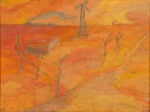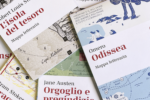Milton Caniff – Masters of Black and White
 (1200x800).jpg)
Mostra personale.
Comunicato stampa
The PAFF! museum presents original comic-strip drawings by Milton Caniff, one of Hugo Pratt's greatest influences, in an exhibition exploring the connection between comics, cinema, music and fashion in the ‘30s and ‘40s.
Berlin, 15/12/2020 - Presenting some of the less familiar pages in our history through the drawings of one of the greatest cartoonists the world has seen... This is the goal of the new exhibition “Masters of black and white: Milton Caniff”, opening at the PAFF! museum on its second anniversary.
With this exhibition, PAFF! Palazzo Arti Fumetto Friuli confirms its multidisciplinary mission, using cartoons as a platform to explore various areas of culture and encompass a wide variety of fields, including history, science and art, reaching everybody through the vivid power of images.
This exhibition celebrates the work of great American cartoonist, Milton Caniff. He is considered the “Rembrandt of comics”, one of the most important and influential artists in the history of cartoons, and a huge influence on Hugo Pratt, offering audiences an exciting world of femmes fatales and great adventurers with his drawings throughout the 1930s and ‘40s.
The exhibition is not only a chance to become familiar with this great cartoonist, but also an opportunity to explore a period, sandwiched between the two world wars, bubbling with different influences and great change in many areas, from cinema to fashion and music.
“Our Milton Caniff exhibition...” – states Giulio De Vita, artistic director and founder of PAFF! “...is the first in a series dedicated to masters from the history of comics around the world, entitled ‘Masters of Black and White’, bringing original drawings of great value to Italy for the first time. It also forms part of the project for creation of a permanent collection focused on storytelling through images at the Palazzo del Fumetto di Pordenone. Through the artworks, the exhibition explores the social, cultural and historical contexts in which they were created, offering insights into other artistic disciplines that influenced the artist’s work.”
Presentation of the 61 original drawings by the cartoonist, also paints a picture of the times in which Caniff lived, providing a key for a critical yet participatory interpretation of society in the inter-war period. Throughout his career, this great cartoonist sought to achieve an attentive and expressive representation of the world around him, focusing on every last detail. This included the clothes and hairstyles of his female characters, for whom Caniff drew inspiration from the pages of Vogue, and the use of low-angle cinematic shots, openly citing the stylistic conventions of revolutionary directors of his times such as Orson Welles and Alfred Hitchcock.
In line with regulations to prevent the spread of Covid-19, the exhibition has been staged in the historic rooms of Villa Galvani in Pordenone and is accessible online in the form of a virtual tour (www.paff.it), thanks to the use of camera technology offering 360° high-definition views of the exhibition spaces.
The exhibition centres around a collection from the 9éme Art gallery in Paris, presented for the first time in Italy, with strips including “Terry and the Pirates”, “Male Call”, “Dickie Dare” and “Steve Canyon”, which represent a real cornerstone in the history of comics, and which have fuelled the imaginations of generations of readers.
These precious original drawings, with values reaching € 100,000, are presented alongside complementary content prepared by Luca Raffaelli, with thematic multimedia materials encompassing a variety of fields including the cinema, music and fashions of the period.
The exhibition is presented with the support of the Regional Authority of Friuli-Venezia Giulia and the Municipality of Pordenone
It has been produced in collaboration with the 9éme Art gallery of Paris and with thematic contributions from the Museum of Fashion and Applied Arts of Gorizia.
A revolution in images: from the cinema of Orson Welles to “Caniff the director”
The exhibition also portrays the world of cinema in a period that saw the arrival in theatres of the landmark work “Citizen Kane” by Orson Welles, which redefined the rules of cinematic expression. Milton Caniff yet again established himself as an artist very keenly in step with his times, striving to bring the images, habits, ideas and changes of his society and culture into his work. His comic strips feature use of perspectives that were unique in the cartoon world at that time, and which openly draw on the great director and his use of unprecedented, high-impact angles, with the intent of generating dynamic and emotionally engaging visuals. To further explore the relationship between cartoonist and the cinematic language of his times, the exhibition includes a range of material that helps the visitor to understand the meanings of these expressive choices as a “director”, taking a journey through plots, images and texts.
The thirties and forties through music
An account presenting a complex, multifaceted picture, passing from image to sound, telling the story of a period in the history of American society that, like our own, was marked by profound changes and saw the birth of hugely successful musical genres. In these years between the wars, with the growth of radio, the United States saw a real explosion in musical genres and a melting pot of influences that changed the face of music, including jazz and swing. The content curated by Cristian Carrara, artistic director of the Pergolesi Spontini musical foundation in Jesi, tells the story of this fertile period in the history of music.
In addition, a series of themed radio broadcasts, transmitted on the PAFF! radio station and a programme of podcasts created by DJ Zellaby provide the audience with a selection of music from the period, ranging from blues to swing and bebop.
Milton Caniff’s characters: a trip through the history of fashion
The imaginary world created by the cartoonist demonstrates a special attention for the clothing and fashions of his times and for the highly expressive nature of these elements in representation of different types of people. Throughout his career, Caniff paid tribute to the world of fashion, creating true stage costumes for his characters, presented using strongly characterised outfits that were very typical of the times. The theme of fashion and its communicative power within the exhibition allows us to perceive the cartoonist’s interpretation of his times, and the contemporary nature of his work, closely following the development of fashion and popular trends. Multimedia content curated in collaboration with the Museum of Fashion and Applied Arts of Gorizia allows visitors to immerse themselves in the atmosphere of ‘30s and ‘40s fashion and pick up on the references to models that the master cartoonist took as inspiration, presenting images and clips of vintage outfits and accessories, bringing the period to life and outlining the context in which Milton Caniff was able to create comic strips with such unmistakeable style.
PAFF! PALAZZO ARTI FUMETTO FRIULI
The PAFF! Palazzo Arti Fumetto Friuli museum of Pordenone is the first cultural institution in Italy and one of only a handful in Europe that promotes the exploration of art, science and history through the world of cartoons, allowing vivid and engaging exploration of cultural themes. Using the intuitive and playful language of imagery, PAFF! presents temporary exhibitions, training courses, recreational/educational initiatives, events and conferences for a wide range of audiences.
Founded in 2018 by Giulio De Vita, together with a team of professionals from many different fields, PAFF! uses the world of cartoons to interact with audiences in a creative, smart and multidisciplinary way and to offer them an entertaining approach to culture.
PAFF! is managed by Associazione Vastagamma APS and supported by the Regional Authority of Friuli-Venezia Giulia and the Municipality of Pordenone. Initially conceived as an experimental project, it is now a permanent institution promoting culture, supporting professional training, facilitating social sharing and promoting local activities. This is made possible by its original approach and its ability, using the fundamental characteristics of cartoons, to bring together typically distinct fields and themes such as art, science and social disciplines.



